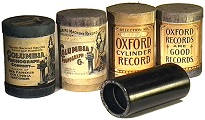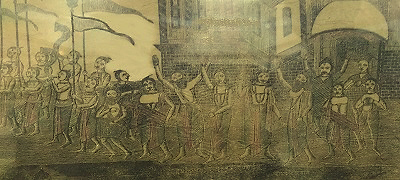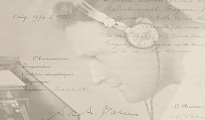Kirtan and Kirtaniya
This chapter is made of ten sub-chapters, covering various aspects of Arnold Bake’s love for and quest of Bengal’s kirtan, devotional songs sung to Radha and Krishna and to the fifteenth-sixteenth century Bhakti saint of Bengal, Chaitanya Mahaprabhu. Arnold Bake felt very drawn to this music, so much so that he took lessons from master kirtaniyas in Calcutta and even performed in Vrindavan in the 1940s. While following Bake’s sounds, I have physically and sonically moved through places where he had been as well as places where he wanted to go but could not. This chapter is about unfinished journeys, both Bake’s and mine.
During this trip to Mainadal in Birbhum, West Bengal, following sounds recorded by Arnold Bake in 1933 and Deben Bhattacharya in 1954, seeds of a relationship of sharing and trust were planted, which have borne fruit over these past eight or so years, leading to the digging into family archives by the Mitra Thakurs.
These are the Niyomsheba songs or ritualistic singing in praise of Chaitanya and his five principal disciples, that the Mitra Thakurs of Mainadal sing for a whole month after Durga puja, starting from the eleventh day of the full moon, or Shoyon Ekadoshi. It lasts a month and ends on Utthan Ekadoshi. In contrast to the essentially public and amplified Nandotshob singing, these are private rituals of the family and intimate in nature.
Between 24-26 November 1931, Arnold Bake had made recordings on cylinders and film of the Rash Utshob in Mongoldihi village in Birbhum, halfway between Suri and Santiniketan.I went to Mongoldihi on another 25 November, 84 years after Arnold Bake. I went with the painter Milan Mitra Thakur, whom I had first met in Mainadal.
Oliver Weeks is a British composer and multi-instrumentalist with whom I have been collaborating since 2002. I gave him some of Arnold Bake’s kirtan notations to sing for me. Notations are a kind of translation in which a sound becomes a sign; in singing Bake’s notation, Olly was translating the script back to sound.
Seema Acharya is a renowned singer of kirtan. Her guru was the Late Chhabi Bandopadhyay, who in turn was a student of Nabadwip Brojobashi, who also taught Arnold Bake. She listens to Olly reading/singing Bake’s kirtan notation, and responds.
There was an address Bake’s biographer, Bob van der Linden had given to me, for the house of Arnold Bake’s teacher of kirtan in Calcutta in the 1940s, Nabadwip Chandra Brojobashi. I went to look for the house in Beleghata in north Calcutta, and found it. I also found details of curious interest.
It is interesting how in my work, different erstwhile unconnected places and people and places have got connected through the act of shared listening. Here is my telephonic conversation with Nirmalendu Mitra Thakur on Bake’s kirtan recordings from Kenduli and Mongoldihi.
These are 17 clips of varying length from footage of 1994, in which there are kirtaniyasfrom Mainadal whom Arnold Bake had recorded in 1933, as well as some whom we met in 2014 and later. Hence, there is a continuity here, of almost a hundred years, of a family that has been singing kirtan for five centuries.
Arnold Bake knew that students from Manipur used to come to Mainadal to their ‘tol’ to study the kirtan with the Mitra Thakurs. When he came to India for the last time in 1955, he wanted very much to go to Manipur, but couldn’t. What would he find if he went there then? How is kirtan performed in Manipur now?
Sumati Devi is one of the few women who sing the Manoharsai in Manipur today.



